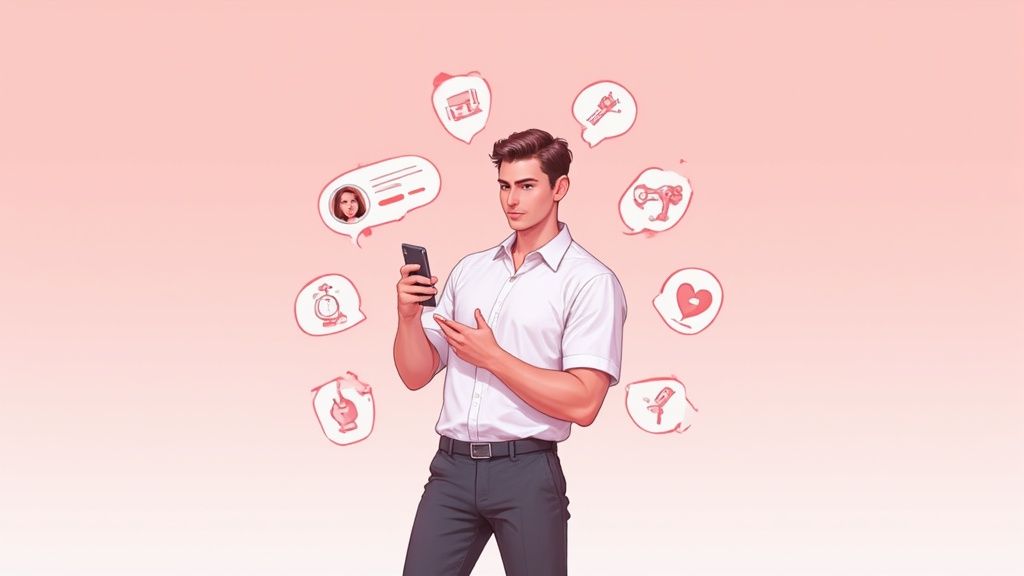Online Dating Industry Statistics You Need to Know in 2025
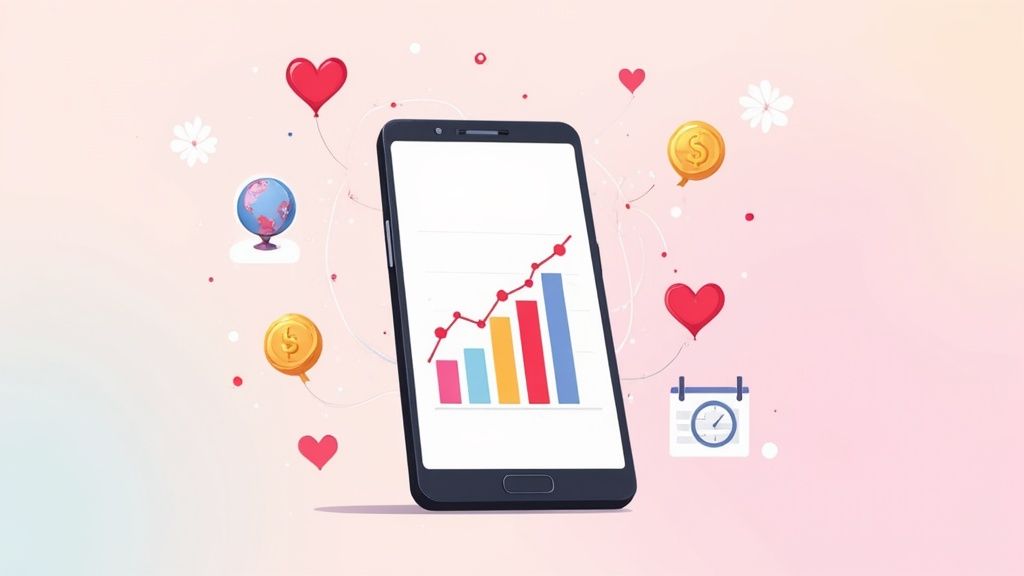
The way we find love has fundamentally changed. Once a niche pursuit, online dating has exploded into a multi-billion dollar global phenomenon, reshaping social norms and romantic connections. But beyond the swipes and matches lies a complex industry driven by powerful data. Understanding the latest online dating industry statistics is no longer just for marketers or sociologists; it's essential for anyone navigating this digital terrain. Whether you're an individual user looking to optimize your profile, a consultant managing client accounts, or an agency scaling its services, these numbers provide a crucial roadmap.
This roundup decodes the data, offering a clear view of the market's scale, user behaviors, and emerging challenges. We will unpack the most critical statistics that define the state of online dating today, revealing the trends and surprising realities behind the screen. From market valuation and user engagement to the real-world outcomes of digital matchmaking, this article provides the insights needed to make informed decisions. We will explore the financial growth, user demographics, success rates, and the significant privacy concerns that shape the experience for millions. By examining these key data points, you'll gain a strategic advantage in achieving your goals within this massive and influential industry.
1. Global Online Dating Market Worth $10.87 Billion (2024)
The sheer scale of the digital romance landscape is one of the most compelling online dating industry statistics. In 2024, the global online dating market is valued at an impressive $10.87 billion. This valuation underscores the profound shift in how people seek relationships, moving from traditional methods to sophisticated digital platforms. The market's robust health is further highlighted by projections that it will expand to $14.87 billion by 2030, signaling sustained growth and innovation.
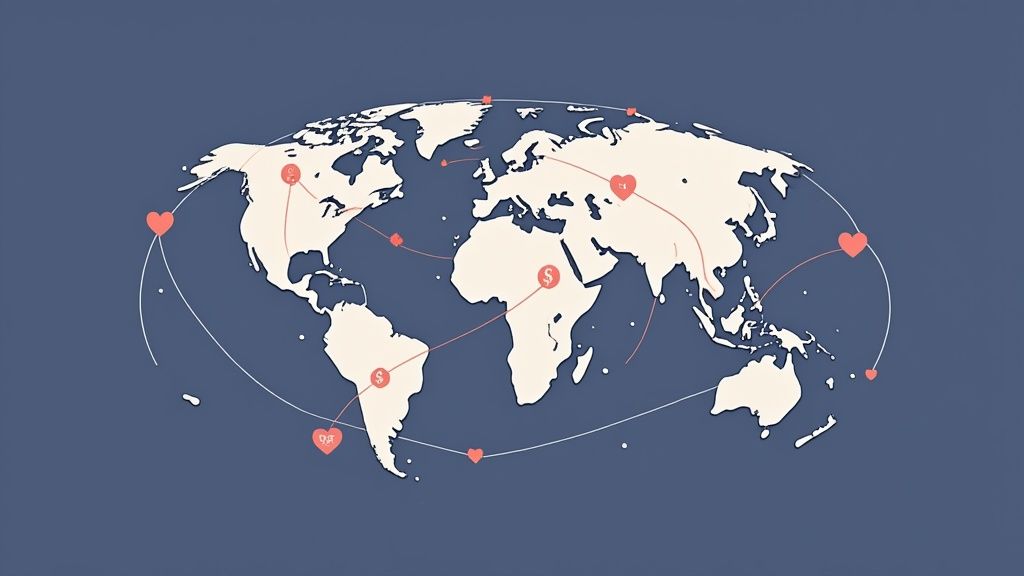
Market Leaders and Revenue Streams
This multi-billion dollar valuation is driven by industry giants. For instance, Match Group, which owns Tinder, Hinge, and Match.com, reported revenues of $3.19 billion in 2023. Similarly, Bumble Inc. generated $934 million in the same year. These figures are fueled by a mix of subscription models, freemium services, and in-app purchases for premium features, demonstrating a diverse and effective monetization strategy across the industry.
Actionable Insights for Stakeholders
Understanding this market size provides critical context for various stakeholders, from investors to entrepreneurs looking for an entry point.
- For Investors: Consider diversifying investments across established players and emerging niche platforms to balance risk and growth potential.
- For Entrepreneurs: Focus on underserved demographics or specialized interests. The market's size allows for profitability even within smaller segments. For those interested, you can find valuable tips on how to start a matchmaking business.
- For Marketers: Monitor user engagement and retention metrics, as these are key indicators of a platform's long-term health and profitability in a competitive landscape.
2. 366 Million Global Users of Online Dating Services
The sheer number of people using digital platforms to find a partner is one of the most significant online dating industry statistics. As of 2024, an estimated 366 million people worldwide are active on dating apps and websites, a figure that represents approximately 4.6% of the global population. This massive user base demonstrates the widespread cultural acceptance of online dating and its evolution into a primary method for forming new connections. Furthermore, the user pool is projected to grow to over 440 million by 2027, indicating continued momentum and market penetration.
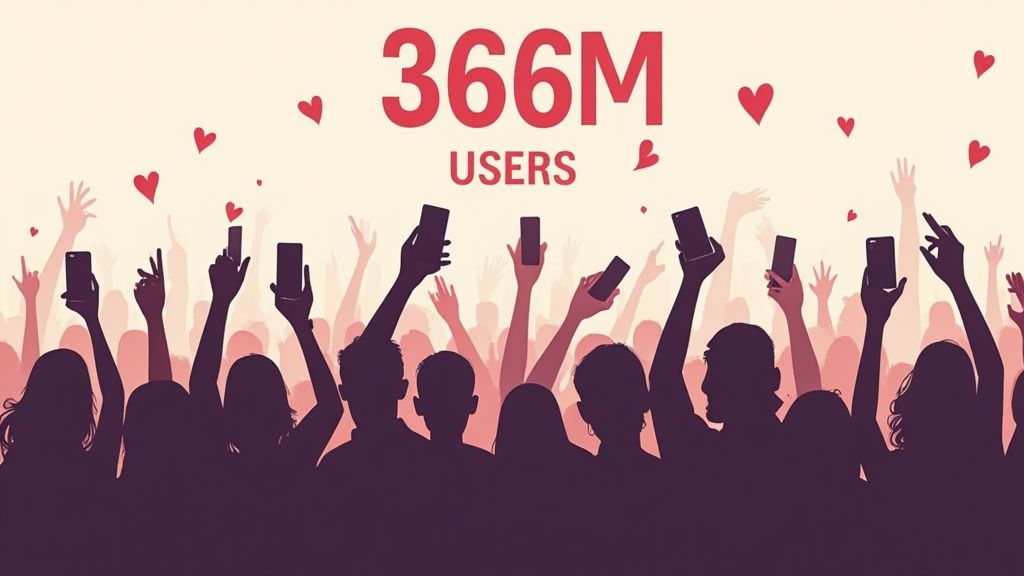
User Base of Major Platforms
The global user count is dominated by several key players. For instance, Tinder leads the pack with approximately 75 million monthly active users, while Bumble reports over 42 million. Legacy platforms also maintain a strong presence; Match.com operates in over 50 countries, and OkCupid has facilitated connections for tens of millions of users. These numbers illustrate the immense scale and reach of the industry's top platforms, which cater to a diverse international audience.
Actionable Insights for Stakeholders
This large and growing user base presents both opportunities and challenges for everyone involved in the online dating ecosystem.
- For Users: To stand out in a crowded digital space, create a detailed and authentic profile that showcases your personality. Instead of feeling overwhelmed, be selective and intentional with your interactions to improve match quality.
- For Entrepreneurs: The vast user base confirms a consistent demand. Consider developing niche platforms that cater to specific communities or interests, as even a small segment of this global audience can create a viable business.
- For Marketers: A large audience allows for hyper-targeted advertising campaigns. Segment users based on demographics, behavior, and location to deliver relevant promotions and increase conversion rates effectively.
3. 30% of U.S. Adults Have Used Dating Apps or Websites
One of the most telling online dating industry statistics is the sheer pervasiveness of these platforms in modern society. According to the Pew Research Center, 30% of U.S. adults have used a dating site or app. This figure highlights the widespread adoption of digital matchmaking and its transition from a niche activity to a mainstream method for finding partners. The normalization of online dating is a fundamental driver of the industry's growth and cultural significance.
Crucially, this adoption translates into real-world success. The same study found that 12% of American adults are in a committed relationship or marriage with someone they met online. This statistic validates the effectiveness of these platforms, moving them beyond casual connections to serious relationship builders. Platforms like Hinge actively market themselves as being "designed to be deleted," while eHarmony famously claims responsibility for 4% of all U.S. marriages, reinforcing their role in fostering long-term commitments.
Actionable Insights for Stakeholders
This high adoption rate has direct implications for users, platform developers, and marketers seeking to understand user behavior.
- For Users: With such a large user base, it's wise to try multiple platforms to find one that aligns with your specific relationship goals. Success often requires patience and authentic engagement, so setting clear intentions from the start is crucial.
- For Platform Developers: The data confirms a strong market for relationship-oriented apps. Focusing on features that facilitate deeper connections and showcase success stories can attract users seeking serious commitments.
- For Marketers: Leverage testimonials and success stories in campaigns. Highlighting the 12% of adults who found lasting relationships online can build trust and attract a user base that is willing to invest in premium features to achieve similar outcomes.
4. Tinder Generates 75 Million Matches Per Day
The sheer volume of user activity on leading platforms is one of the most staggering online dating industry statistics. Tinder, a dominant force in the market, facilitates approximately 75 million matches daily. This incredible figure is the result of users swiping an estimated 2.4 billion times per day, a testament to the platform's addictive, gamified interface. This high level of engagement highlights Tinder's powerful position, particularly within the casual dating segment, and showcases the immense scale of modern digital interaction.
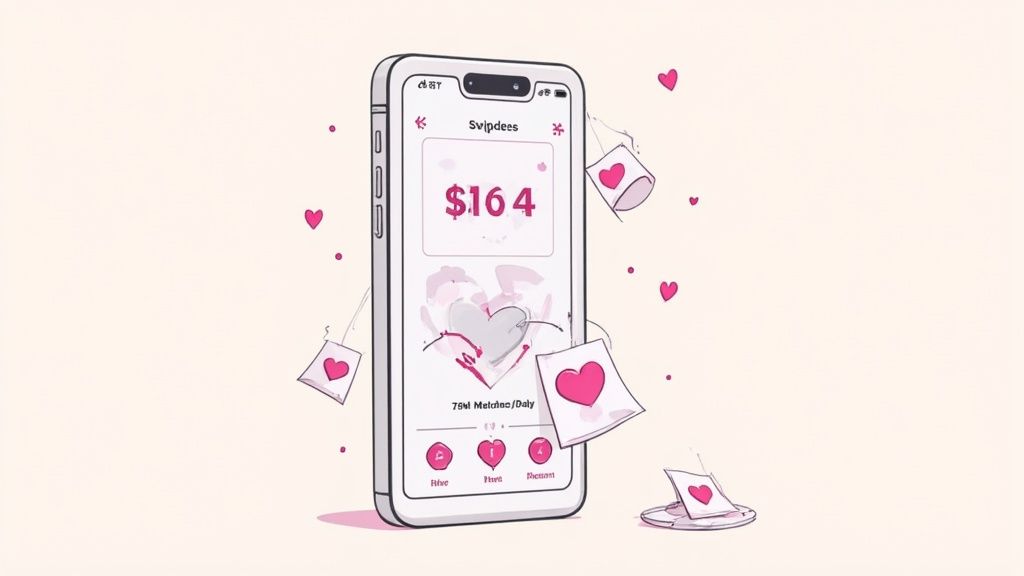
User Engagement and Platform Dominance
Tinder’s success isn't just in numbers; it’s in creating a cultural phenomenon. Features like the 'Swipe Night' interactive series generate millions of engagements, while integrations with Instagram and Spotify allow for richer, more personalized profiles. The platform's 'Swipe Life' content hub even features user success stories, reinforcing its role in modern relationship-building. This ecosystem, pioneered by co-founders Sean Rad and Justin Mateen, demonstrates how a simple mechanism can drive unprecedented user activity and solidify market leadership under Match Group.
Actionable Insights for Stakeholders
This statistic provides crucial lessons on user engagement and market penetration for anyone involved in the digital space.
- For Users: To stand out, create a compelling profile with a high-quality first photo, which can drive up to 80% of swipe decisions. Personalize your first message by referencing a detail from their profile to increase response rates.
- For Entrepreneurs: Study Tinder's gamification model. The swiping mechanism provides instant gratification and encourages repeat usage, a powerful retention strategy for any app.
- For Marketers: The massive daily user volume makes platforms like Tinder a viable channel for targeted advertising campaigns, especially for brands targeting a younger, digitally native audience.
5. 78% of Online Dating Users Are Concerned About Data Privacy
The convenience of digital matchmaking comes with a significant trade-off, as highlighted by one of the most sobering online dating industry statistics: a staggering 78% of users are concerned about their data privacy and security. This widespread apprehension stems from the intimate nature of the information shared on these platforms, from personal preferences and photos to location data. Users are increasingly aware of the risks, including data breaches, the potential misuse of their information, and the threat of scams.
This statistic is not just a perception; it is rooted in real-world events. High-profile incidents, such as the Coffee Meets Bagel breach affecting millions of users and Grindr facing scrutiny for sharing sensitive user data with third parties, have amplified these concerns. The fear of personal information being exposed or exploited is a major factor influencing user trust and platform choice in the online dating world.
Actionable Insights for Stakeholders
Addressing this deep-seated user concern is no longer optional; it's a critical component of a platform's long-term viability and ethical responsibility.
- For Users: Proactively protect your information by using unique passwords, limiting the personal details you share initially, and regularly reviewing your privacy settings. Avoid linking every social media account to your dating profile to minimize your digital footprint.
- For Platform Developers: Prioritize security by implementing robust measures like end-to-end encryption for messages, two-factor authentication, and transparent data policies. Features like Bumble's photo verification help build user trust by combating inauthentic profiles.
- For Marketers: Communicate your platform's security features clearly in all marketing materials. Highlighting a commitment to privacy can be a powerful differentiator that attracts and retains cautious users concerned about their digital safety. Be aware of automated accounts; you can learn more about how to identify online dating bots.
6. 57% of Online Dating Users Report Positive Experiences
Despite common critiques and horror stories, one of the most encouraging online dating industry statistics is that a majority of users have a good time. A 2023 Pew Research Center study found that 57% of people who have used a dating site or app report their overall experiences as positive. This figure highlights that, for most, these platforms successfully deliver value, whether through meaningful connections, enjoyable conversations, or simply expanding their social circles.
Factors Driving User Satisfaction
Positive experiences are often tied to platform-specific features designed to improve match quality and user safety. For example, Hinge’s "Most Compatible" feature is eight times more likely to lead to a date, enhancing user satisfaction. Similarly, Bumble's model, which requires women to initiate conversation, is frequently praised for creating a more comfortable and less harassing environment. These thoughtful designs contribute directly to the positive majority sentiment.
Actionable Insights for Stakeholders
This statistic provides a crucial counterbalance to negative media portrayals and offers guidance for improving user outcomes.
- For Users: To increase your chances of a positive experience, choose platforms that align with your relationship goals. Manage expectations, take breaks to avoid burnout, and prioritize your well-being by following expert advice. You can find essential information in these online dating safety tips.
- For Platform Developers: Focus on features that promote high-quality interactions and user safety. Implementing robust reporting tools and curated matching algorithms can significantly boost satisfaction rates.
- For Marketers: Emphasize success stories and positive user testimonials in campaigns to build trust and attract new users who may be hesitant due to negative stereotypes.
7. 40% of Heterosexual Couples Met Online (Now the Most Common Method)
The transition from traditional courtship to digital matchmaking is one of the most significant online dating industry statistics, fundamentally altering how relationships begin. Recent studies, notably from Stanford sociologist Michael Rosenfeld, reveal that approximately 40% of heterosexual couples in the U.S. now meet online. This milestone officially makes digital platforms the most common way partners connect, surpassing older methods like introductions through friends, family, or meeting at work or bars.
Platform Success and Social Impact
This trend is even more pronounced for same-sex couples, where 65% report meeting their partner online. Major platforms often build their brand around this success. Hinge markets itself as "the relationship app" designed to be deleted, while Match.com has long claimed responsibility for more marriages than any other dating site. This data confirms that online dating is no longer a niche alternative but the primary engine for relationship formation in modern society.
Actionable Insights for Stakeholders
This societal shift offers clear takeaways for users and industry players alike, highlighting the mainstream acceptance and effectiveness of digital dating.
- For Users: Treat your online dating efforts with the same seriousness you would an in-person meeting. Be clear about your intentions to attract compatible matches and transition from messaging to a real-world date in a timely manner.
- For Platform Developers: Emphasize success stories and relationship-focused features. Metrics that showcase successful long-term matches can be a powerful marketing tool to attract users seeking serious commitments.
- For Marketers: Leverage campaigns that normalize online dating as the primary path to love. Showcasing authentic user testimonials and success stories, like Bumble's "#BumbleSuccess" campaign, can build trust and resonate with a broad audience.
8. 71% of Dating App Users Never Go On A Date
One of the most surprising online dating industry statistics reveals a significant disconnect between online activity and real-world outcomes. A staggering 71% of dating app users report never having met someone in person from their digital connections. This figure highlights a major challenge within the industry: converting online engagement into offline dates. The gap is often attributed to issues like endless texting, fear of rejection, ghosting, and a general lack of serious intent from users who may be browsing more for entertainment than for a genuine relationship.
This timeline infographic visualizes the sharp drop-off between making a digital match and an actual in-person meeting.
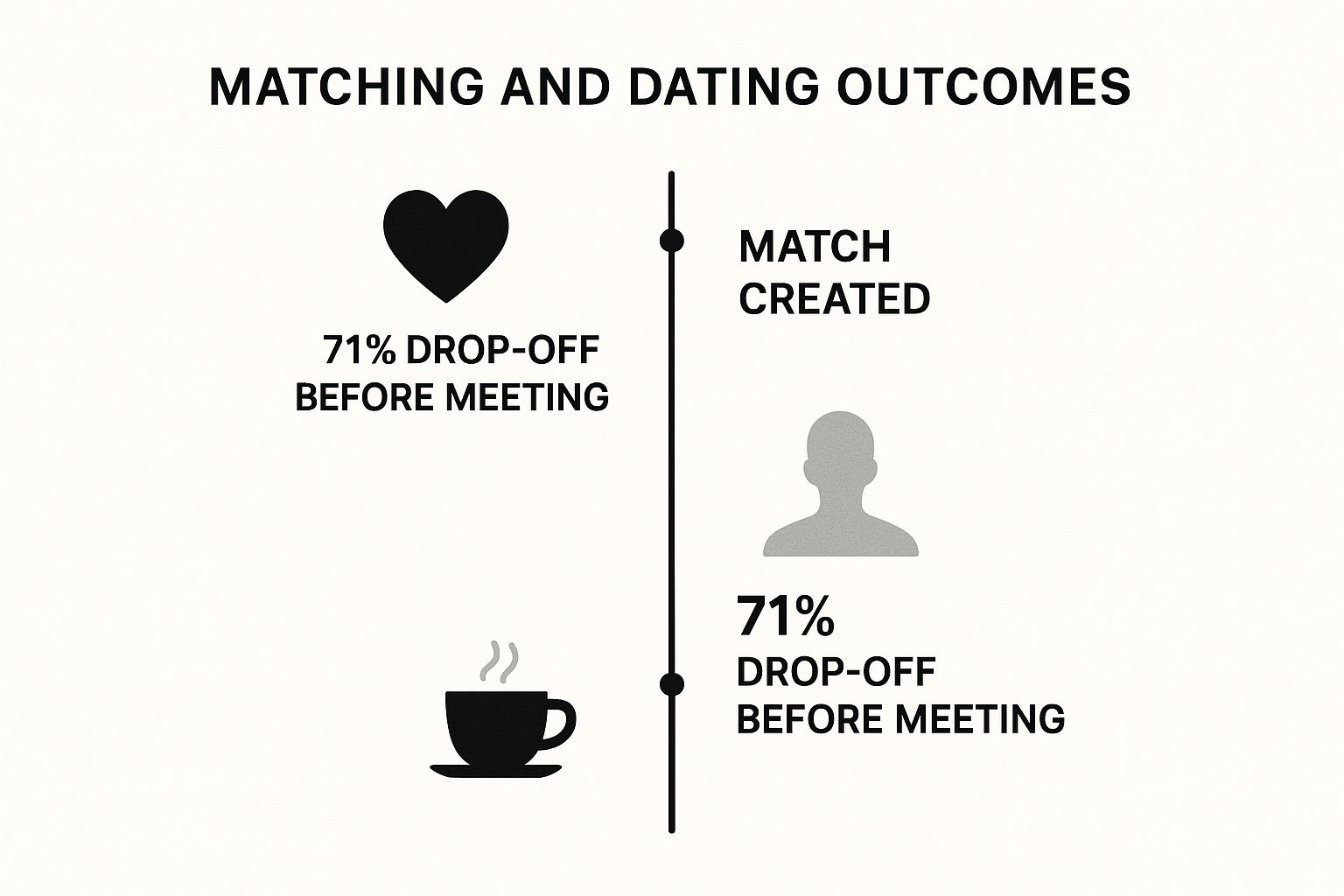
The visualization underscores how the vast majority of online interactions fail to progress to the critical next step, leaving only a minority of users to meet face-to-face.
Addressing the Engagement Gap
In response, leading platforms have introduced features designed to bridge this divide. Hinge, for example, launched a "We Met" feature to gather feedback on actual dates and refine its algorithm. Likewise, Bumble's time-limited messaging encourages users to take action quickly, while apps like Thursday create urgency by only functioning one day a week to promote same-day dates. These innovations show a clear industry trend toward facilitating real-life connections over perpetual swiping.
Actionable Insights for Stakeholders
Users and platform developers can take specific steps to improve the match-to-meeting conversion rate.
- For Users: Propose a specific date idea within the first 7-10 messages to avoid getting stuck in a "pen pal" cycle. Using a video call as an intermediate step can also build comfort and verify intentions.
- For Entrepreneurs: There is a market opportunity for apps that prioritize quality interactions over quantity. Consider models like Coffee Meets Bagel, which provides a limited number of curated matches daily.
- For Marketers: Campaigns should focus on success stories of real dates and relationships, not just on the volume of matches. This can help attract users with more serious intentions.
9. Average Cost of $20-40 Per Month for Premium Dating App Subscriptions
The monetization of user engagement is one of the most significant online dating industry statistics, with premium subscriptions forming the financial backbone of most platforms. On average, users can expect to pay between $20 and $40 per month for enhanced features. This price point reflects a strategic balance, making premium access attainable for serious users while generating substantial, recurring revenue for the companies.
The cost structure is often tiered, encouraging longer commitments. For example, a single month of Tinder Platinum might cost $40, while a six-month subscription could bring the monthly price down significantly. Similarly, Bumble Premium and Hinge+ fall within this range, offering perks like unlimited likes, advanced filters, and profile boosts. This model successfully converts free users into paying customers by promising a more efficient and successful dating experience.
Actionable Insights for Users
Understanding the cost-benefit analysis of these subscriptions is key for daters looking to optimize their investment in finding a partner.
- For New Users: Always start with the free version of an app to gauge its user base and functionality before committing to a paid plan.
- For Budget-Conscious Daters: Look for promotional discounts or opt for a longer subscription term after a successful one-month trial to lower the average monthly cost.
- For Strategic Daters: Evaluate whether premium features directly address your specific dating challenges. If you're not getting matches, a "boost" might be more valuable than "unlimited likes." Carefully consider the return on investment before upgrading.
10. 60% of Female Dating App Users Experience Harassment
One of the most sobering online dating industry statistics highlights a critical safety issue: approximately 60% of women on dating apps report experiencing some form of harassment. This alarming figure, often cited in studies by organizations like the Pew Research Center, encompasses behaviors ranging from unsolicited explicit messages and offensive name-calling to threats of physical harm. It underscores the urgent need for platforms to address user safety and improve the quality of the online dating experience, particularly for female users who are disproportionately affected.
Industry Responses and Safety Features
In response, many platforms have implemented features aimed at curbing harassment. Bumble famously requires women to initiate conversations, giving them control over who can message them. Tinder introduced AI-powered tools like "Does This Bother You?" to detect and flag inappropriate language in real-time. Meanwhile, Match Group has partnered with safety organizations like RAINN to enhance prevention and reporting protocols. Features like photo verification, robust blocking mechanisms, and in-app safety guides are becoming standard across the industry.
Actionable Insights for Users
Navigating this environment requires awareness and proactive safety measures. Users can significantly improve their experience by taking control of their digital safety.
- For All Users: Prioritize platforms known for strong safety features and community guidelines. Immediately block and report any user who exhibits harassing or inappropriate behavior.
- For Women: Trust your instincts. If a conversation makes you uncomfortable, it is perfectly acceptable to unmatch without explanation. Keep personal details like your last name, workplace, or address private until you have established trust.
- For Men: Be an ally. Report harassment when you see it, respect boundaries, and contribute to a safer and more positive community for everyone.
Key Statistics Comparison of Online Dating Industry
| Item Title | Implementation Complexity | Resource Requirements | Expected Outcomes | Ideal Use Cases | Key Advantages |
|---|---|---|---|---|---|
| Global Online Dating Market Worth $10.87 Billion (2024) | High - Requires broad market infrastructure and regulation management | Significant investment in technology, marketing, and customer service | Large revenue generation, market growth, and innovation | Investors, large companies aiming for market share | Strong investor confidence, employment opportunities, market sustainability |
| 366 Million Global Users of Online Dating Services | Moderate - User base management and platform scalability | Robust server capacity, UX/UI design, and user support | Extensive reach and network effects for matches | Platforms targeting mass user adoption and diversity | Large user pools, diverse demographics, global connectivity |
| 30% of U.S. Adults Have Used Dating Apps or Websites | Moderate - Platform usage tracking and demographic targeting | Marketing, data analysis, and platform optimization | Normalization of online dating, relationship formation | US-based platforms focusing on mainstream adoption | Reduces stigma, proven relationship success, niche benefits |
| Tinder Generates 75 Million Matches Per Day | High - Real-time data processing and engagement mechanics | Advanced algorithms, server resources, and global availability | High user engagement and match volume | Casual dating, high-volume user interaction | Gamified swiping boosts engagement, broad reach, immediate feedback |
| 78% of Online Dating Users Are Concerned About Data Privacy | Moderate - Requires strong security and compliance measures | Investment in security tech, privacy policies, and audits | Increased user trust and platform accountability | Privacy-conscious users and regulated markets | Drives platform security improvements, regulatory compliance |
| 57% of Online Dating Users Report Positive Experiences | Moderate - Focus on UX improvements and satisfaction measurement | Customer support, quality control, and continuous updates | Majority user satisfaction and retention | Relationship-focused platforms and user experience optimization | Validates platform value, reduces stigma, promotes safety |
| 40% of Heterosexual Couples Met Online (Now Most Common Method) | Moderate - Tracking long-term relationship origin data | Data analytics, marketing, and social proof development | Mainstream acceptance, changing dating culture | Platforms supporting serious relationships and broad demographics | Confirms legitimacy, expands dating pools, encourages offline transitions |
| 71% of Dating App Users Never Go On A Date | Moderate - Need features encouraging real-life meetings | Feature development for conversion tracking and user education | Highlights engagement gaps, opportunity to improve conversions | Platforms focusing on serious dating success | Encourages real meetings, manages user expectations, drives innovation |
| Average Cost of $20-40 Per Month for Premium Dating App Subscriptions | Low to Moderate - Subscription billing and feature gating | Payment processing, customer management, and premium feature development | Increased revenue from premium users and service enhancements | Platforms monetizing through subscriptions | Filters serious users, supports platform investment, competitive features |
| 60% of Female Dating App Users Experience Harassment | High - Requires advanced moderation and safety implementations | AI moderation, reporting tools, safety education, and policy enforcement | Safer user environment, improved female user retention | Platforms prioritizing female safety and harassment reduction | Promotes safety, drives innovation in moderation, encourages women-first design |
What These Numbers Mean for Your Swiping Strategy
The comprehensive array of online dating industry statistics we've explored paints a vivid and complex picture of modern romance. The data reveals a landscape teeming with opportunity, yet riddled with distinct challenges. On one hand, the industry is a global behemoth worth over $10 billion, connecting hundreds of millions of people and now serving as the single most common way heterosexual couples meet. This confirms that digital platforms are not just a niche, but the primary frontier for finding a partner in the 21st century.
However, the numbers also highlight a significant disconnect. With 71% of users never progressing to an actual date, it’s clear that a massive amount of time and energy is invested with no real-world payoff. This digital friction, combined with the substantial monthly cost of premium features and legitimate concerns over harassment and data privacy, contributes to widespread user burnout. The paradox is that while the pool of potential partners is larger than ever, the process of finding one has become a game of volume and endurance that many find exhausting.
Turning Statistics into a Strategic Advantage
So, what is the actionable takeaway from this data-driven deep dive? The key is to shift from being a passive participant to an informed, strategic user. Understanding these statistics empowers you to navigate the digital dating world with purpose and efficiency. The goal is no longer just to swipe, but to swipe smarter.
- Acknowledge the Volume Game: The statistic that Tinder alone generates 75 million matches daily proves that success is tied to activity. To stand out, you need a consistent presence, but this shouldn't come at the cost of your mental well-being or your valuable time.
- Bridge the Online-Offline Gap: The most telling statistic is the high percentage of users who never meet in person. This highlights the critical need to move promising conversations offline quickly and efficiently. Your strategy should prioritize converting digital interest into real-world interactions.
- Maximize Your Investment: With subscriptions costing $20-$40 per month, online dating is a financial investment. To see a return, you must adopt a strategy that maximizes your profile's visibility and engagement, ensuring your money is well-spent.
Ultimately, the most successful online daters are those who understand the system they are operating within. They recognize that the path to a meaningful connection often requires navigating a high-volume, competitive environment. By leveraging the insights provided by these online dating industry statistics, you can protect yourself from the common pitfalls of burnout and frustration. Instead of being overwhelmed by the numbers, you can use them to build a smarter, more effective, and ultimately more rewarding dating strategy.
Ready to turn these insights into action and conquer the volume game? Auto-Swiper is designed to handle the repetitive, time-consuming aspects of swiping, so you can focus your energy on meaningful conversations and real-life dates. Stop wasting time and start getting results by automating your activity with Auto-Swiper today.
